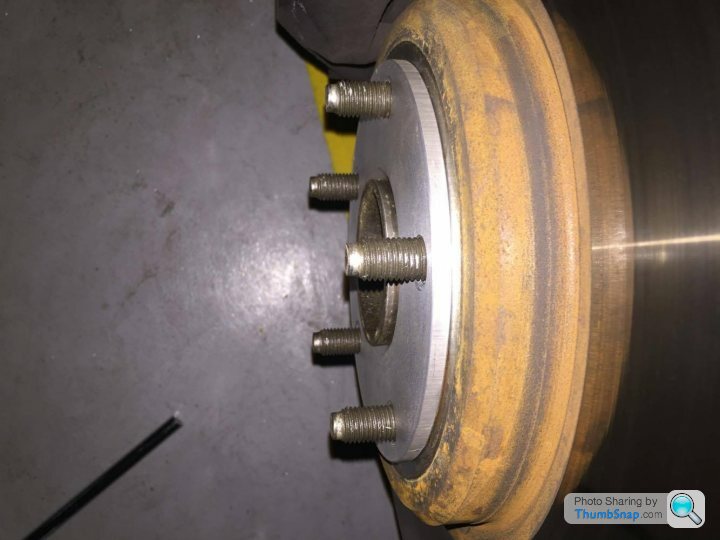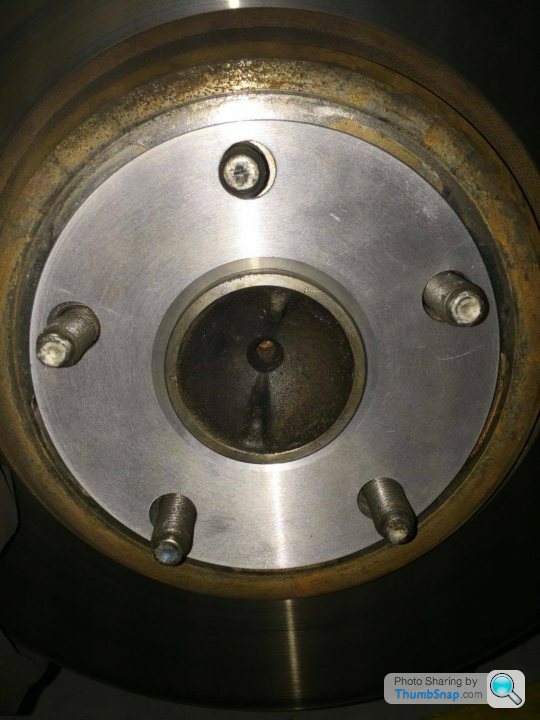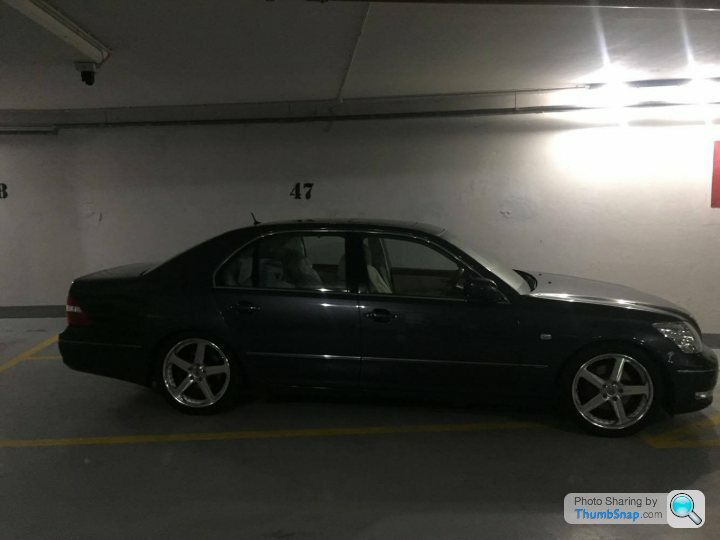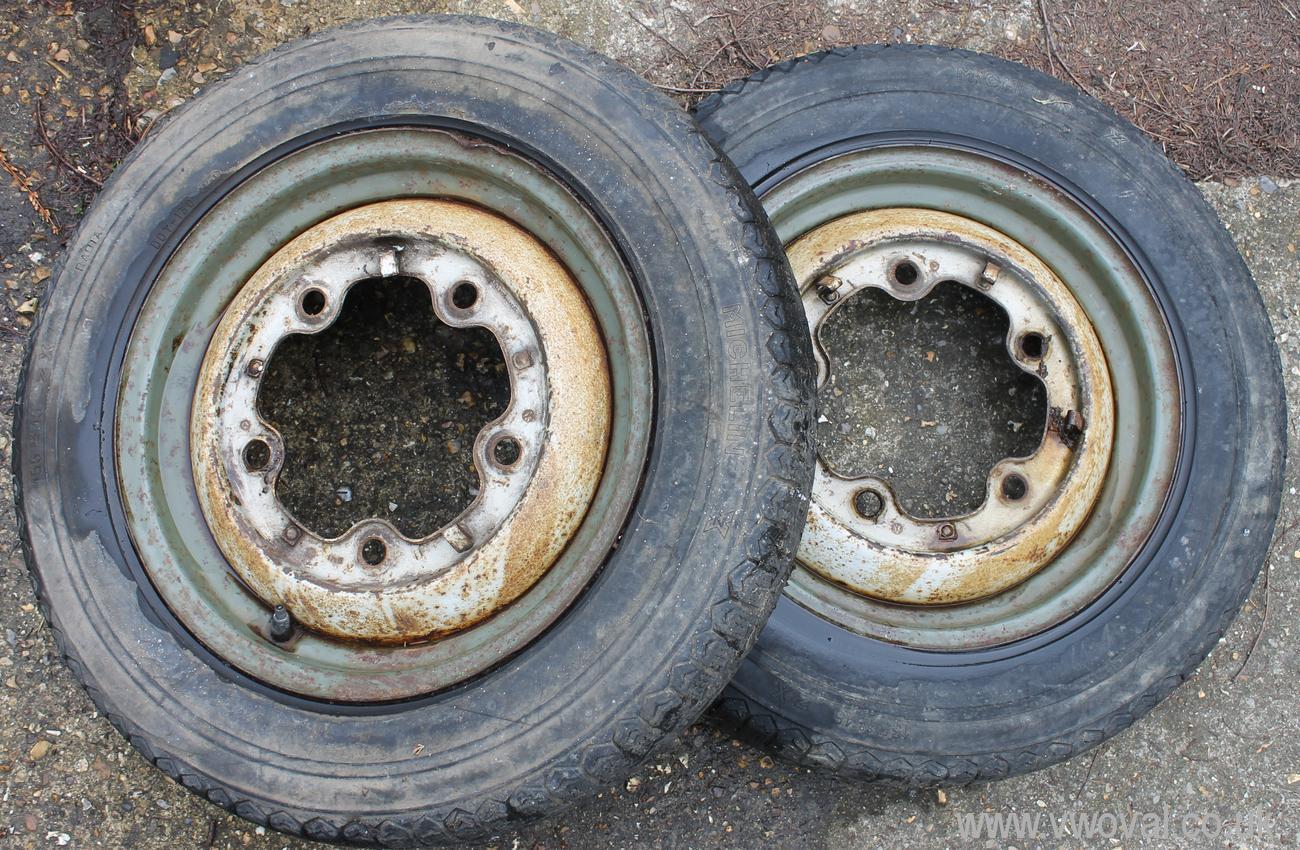Spigot rings and spacers conundrum
Discussion
Bought a set of RTS Trafficstar wheels for the LS430 however i will need to run 3 or 5mm spacers up front in order to clear the brake calipers which are huge,
My question is the hub lip only protrudes around 8mm from without a spacer, With the spacer this gives me around 3 mm on which to mount the wheel,
I was told by our local tyre fitter that this would be dangerous as the weight of the car rests on the central hub as opposed to the bolts and 3mm wouldn't be enough. I was of the impression that the central hub is mainly for centralising the wheel and the clamping force of the wheel studs is what provides the strength.
I will post pictures shortly but I was wondering if anyone could clarify what is safe and what isn't.
Without Spacer

With Spacer



I have only fitted 2 just to test fit prior to running out to buy spigot rings again (Tried last night and the tyre fitter told me it was too dangerous so left without them.
Would be a shame as they look pretty good on the car

I get at least 6.5 - 7 turns on each of the bolts so I'm thinking that should be plenty...
Thanks in advance
My question is the hub lip only protrudes around 8mm from without a spacer, With the spacer this gives me around 3 mm on which to mount the wheel,
I was told by our local tyre fitter that this would be dangerous as the weight of the car rests on the central hub as opposed to the bolts and 3mm wouldn't be enough. I was of the impression that the central hub is mainly for centralising the wheel and the clamping force of the wheel studs is what provides the strength.
I will post pictures shortly but I was wondering if anyone could clarify what is safe and what isn't.
Without Spacer

With Spacer



I have only fitted 2 just to test fit prior to running out to buy spigot rings again (Tried last night and the tyre fitter told me it was too dangerous so left without them.
Would be a shame as they look pretty good on the car


I get at least 6.5 - 7 turns on each of the bolts so I'm thinking that should be plenty...
Thanks in advance
andy-xr said:
Bolts provide horizontal force, not vertical, as in, they'll keep the wheel tight but they're not to be used for putting a weight/load on them from above. Find different wheels/spacers
They provide vertical force by clamping the surfaces together horizontally, in the same way they provide tangential force to apply acceleration / braking torque.Mave said:
andy-xr said:
Bolts provide horizontal force, not vertical, as in, they'll keep the wheel tight but they're not to be used for putting a weight/load on them from above. Find different wheels/spacers
They provide vertical force by clamping the surfaces together horizontally, in the same way they provide tangential force to apply acceleration / braking torque.Wheels are a bolted joint, the strength comes from the bolts being torqued properly and the friction from the surfaces. The idea that the whole weight is put through the thin hub spigot is silly, that's there to ensure the wheel is held central.
In which case OP, assuming you have enough turns of engagement on the bolts, you'll be fine.
You're tyre fitter is incorrect. The spigot on the hub carries zero load, if it did why would they make spigot rings out of cheap plastic? It is there purely to help with centralizing the wheel when fitting it. You're wheel is held on by the frictional grip between the hub fave and wheel face generated by doing up the wheel nuts. There are plenty of OE set ups around with no spigot and they locate using the wheel nuts. This is why you should always do wheel nuts up in a diagonal pattern.
Spacers look fine, you are probably right on the edge of what I would be comfortable with regards stud length. I've run and friends also run plenty of race cars with no spigot rings and wheel spacers with zero issues. Just make sure you use the torque settings. nuts and do things up in the correct manner.
Finally, those wheel look ace!
Spacers look fine, you are probably right on the edge of what I would be comfortable with regards stud length. I've run and friends also run plenty of race cars with no spigot rings and wheel spacers with zero issues. Just make sure you use the torque settings. nuts and do things up in the correct manner.
Finally, those wheel look ace!

HorneyMX5 said:
You're tyre fitter is incorrect. The spigot on the hub carries zero load, if it did why would they make spigot rings out of cheap plastic? It is there purely to help with centralizing the wheel when fitting it. You're wheel is held on by the frictional grip between the hub fave and wheel face generated by doing up the wheel nuts. There are plenty of OE set ups around with no spigot and they locate using the wheel nuts. This is why you should always do wheel nuts up in a diagonal pattern.
Spacers look fine, you are probably right on the edge of what I would be comfortable with regards stud length. I've run and friends also run plenty of race cars with no spigot rings and wheel spacers with zero issues. Just make sure you use the torque settings. nuts and do things up in the correct manner.
Finally, those wheel look ace!
^^^ this, and others like it. Spacers look fine, you are probably right on the edge of what I would be comfortable with regards stud length. I've run and friends also run plenty of race cars with no spigot rings and wheel spacers with zero issues. Just make sure you use the torque settings. nuts and do things up in the correct manner.
Finally, those wheel look ace!

If the PCD of the wheels is the same as the hub, there is no reason to run spigot rings. The spigot merely centres the wheel WHILST doing up the nuts/bolts. The taper on the nuts/bolts do the final centering and provide the clamping force to the hub.
Air cooled Volkwagens don't even have a spigot, so ask your tyre fitter to explain that one away.

Air cooled Volkwagens don't even have a spigot, so ask your tyre fitter to explain that one away.

Thank you all for your replies! All fitted,
Took it for a drive and no wobbles or shakes at all, (Up to legal-ish motorway speeds in any case) I fitted spigot rings in the end however I don't think they are doing anything at all. I assumed that as the car has studs as opposed to bolts it should centre in any case.
Longer studs are on the cards once I find somewhere to have it done, (I'm in Poland where nobody actually wants to do anything and everyone claims to be an expert so theres no point in trying to argue my point in a language I hardly speak)
Thanks again! I'm so happy with how it looks now
Now to fit the original wheels from this on to the wifes IS200!
Took it for a drive and no wobbles or shakes at all, (Up to legal-ish motorway speeds in any case) I fitted spigot rings in the end however I don't think they are doing anything at all. I assumed that as the car has studs as opposed to bolts it should centre in any case.
Longer studs are on the cards once I find somewhere to have it done, (I'm in Poland where nobody actually wants to do anything and everyone claims to be an expert so theres no point in trying to argue my point in a language I hardly speak)
Thanks again! I'm so happy with how it looks now

Now to fit the original wheels from this on to the wifes IS200!
shakotan said:
If the PCD of the wheels is the same as the hub, there is no reason to run spigot rings. The spigot merely centres the wheel WHILST doing up the nuts/bolts. The taper on the nuts/bolts do the final centering and provide the clamping force to the hub.
Air cooled Volkwagens don't even have a spigot, so ask your tyre fitter to explain that one away.

The centring on the VW wheels is done by the taper on the nuts and the stud holes.Air cooled Volkwagens don't even have a spigot, so ask your tyre fitter to explain that one away.

Some spigot wheels don't have a cup and cone arrangement and use flat captive washers for the clamping force. On these wheels the fit of the spigot and the wheel is very important, less so for wheels with cup and cone fixings.
Suspect that, given conical fixings, then the OP will be ok, considering that car wheel fixings are generally over engineered compared to , say, lorry and bus fittings.
FiF said:
The centring on the VW wheels is done by the taper on the nuts and the stud holes.
Some spigot wheels don't have a cup and cone arrangement and use flat captive washers for the clamping force. On these wheels the fit of the spigot and the wheel is very important, less so for wheels with cup and cone fixings.
Suspect that, given conical fixings, then the OP will be ok, considering that car wheel fixings are generally over engineered compared to , say, lorry and bus fittings.
Yep, tapered seats needed, hope the OP's wheels and nuts have them.Some spigot wheels don't have a cup and cone arrangement and use flat captive washers for the clamping force. On these wheels the fit of the spigot and the wheel is very important, less so for wheels with cup and cone fixings.
Suspect that, given conical fixings, then the OP will be ok, considering that car wheel fixings are generally over engineered compared to , say, lorry and bus fittings.
I had them on a Ford, maybe about 10/12 years ago now, quite common on vans and trucks. In fact the cup and cone fixings aren't liked on heavy vehicles as you lose so much tightening torque with the increased friction, and loss of torque to friction results in less clamping pressure.
HorneyMX5 said:
When was the last time anyone came across wheels with a flat washer set up? I've not seen anything in 20 years of messing with cars that doesn't have tapered nuts/bolts.
Last one I saw was on some 205 GTI Speedlines. Right pain in the arse to find flat bolts for them... :\Krikkit said:
HorneyMX5 said:
When was the last time anyone came across wheels with a flat washer set up? I've not seen anything in 20 years of messing with cars that doesn't have tapered nuts/bolts.
Last one I saw was on some 205 GTI Speedlines. Right pain in the arse to find flat bolts for them... :\FiF said:
shakotan said:
If the PCD of the wheels is the same as the hub, there is no reason to run spigot rings. The spigot merely centres the wheel WHILST doing up the nuts/bolts. The taper on the nuts/bolts do the final centering and provide the clamping force to the hub.
Air cooled Volkwagens don't even have a spigot, so ask your tyre fitter to explain that one away.

The centring on the VW wheels is done by the taper on the nuts and the stud holes.Air cooled Volkwagens don't even have a spigot, so ask your tyre fitter to explain that one away.

Some spigot wheels don't have a cup and cone arrangement and use flat captive washers for the clamping force. On these wheels the fit of the spigot and the wheel is very important, less so for wheels with cup and cone fixings.
Suspect that, given conical fixings, then the OP will be ok, considering that car wheel fixings are generally over engineered compared to , say, lorry and bus fittings.
Gassing Station | General Gassing | Top of Page | What's New | My Stuff



